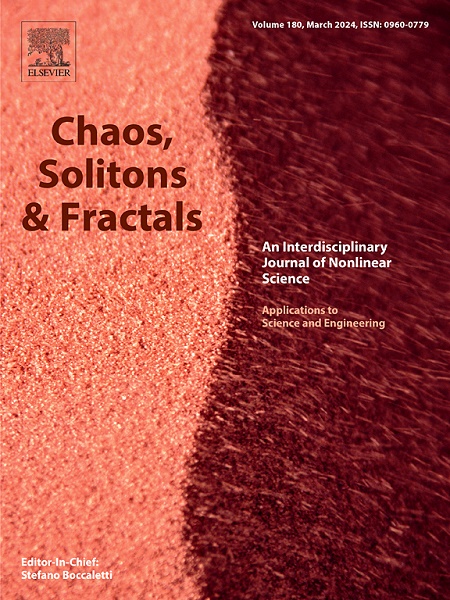Multifractal analysis of thermal infrared of siltstone under uniaxial compression
IF 5.3
1区 数学
Q1 MATHEMATICS, INTERDISCIPLINARY APPLICATIONS
引用次数: 0
Abstract
Engineering practices indicate that in geological engineering, rocks can be in a uniaxial loading state. Siltstone specimens were subjected to uniaxial compression with concurrent infrared thermal image monitoring. Multifractal theory was applied, utilizing the multifractal spectrum and its parameters as quantitative indices for characterizing the infrared field's evolution during failure. On this basis, the multifractal spectrum curvature coefficient was defined to describe the infrared field characteristics. Finally, the evolution relationship between the curvature coefficient and load was investigated, advancing from qualitative to quantitative assessment. The results show that: The multifractal spectrum of infrared thermal image of siltstone has left hook shape and bell shape. The evolution process of multifractal spectrum is closely related to the loading process of siltstone, the pre-peak stage is left hook-shaped, the post-peak stage evolves from left hook-shaped to bell-shaped, and when it fracture, it mutates into left hook-shaped. The evolution trends of multifractal parameters and are similar, they change steadily in the pre-peak stage, increase continuously in the post-peak stage, and suddenly drop to the initial level when fracture occurs. The curvature coefficient of the multifractal spectrum exhibits a slow decrease before the peak, followed by a rapid decrease to a range of 2 to 4 after the peak, and a sudden increase to its initial level upon fracture, with an initial value of approximately 7.5. Through qualitative and quantitative analysis of the correlation between the curvature coefficient and load at the same moment, it was found that during the pre-peak stage, the correlation is predominantly negative, with the area of the negatively correlated envelope being 4.9 times larger than that of the positively correlated envelope. In the post-peak stage, the correlation is predominantly positive, with the area of the positively correlated envelope being 11.7 times larger than the negatively correlated area. This demonstrates that the curvature coefficient can effectively characterize the evolution of load during the loading process of siltstone. The research results provide a new method for the quantitative analysis of thermal infrared fields during the rock failure process, offering new insights for the early warning of engineering rock mass catastrophes.
粉砂岩单轴压缩热红外多重分形分析
工程实践表明,在地质工程中,岩石可以处于单轴加载状态。对粉砂岩试样进行单轴压缩,同时进行红外热成像监测。应用多重分形理论,利用多重分形谱及其参数作为表征失效过程中红外场演化的定量指标。在此基础上,定义了多重分形光谱曲率系数来描述红外场特征。最后,研究了曲率系数与荷载的演化关系,从定性评价向定量评价推进。结果表明:粉砂岩红外热像的多重分形谱具有左钩形和钟形特征;多重分形谱的演化过程与粉砂岩的加载过程密切相关,峰前阶段为左钩形,峰后阶段由左钩形演化为钟形,破裂时突变为左钩形。多重分形参数Δα和Δfα的演化趋势相似,在峰前阶段稳定变化,峰后阶段持续增加,在发生裂缝时突然下降到初始水平。多重分形谱的曲率系数在达到峰值前呈缓慢下降的趋势,在达到峰值后迅速下降至2 ~ 4的范围内,断裂后曲率系数突然上升到初始水平,初始值约为7.5。通过对同一时刻曲率系数与荷载的相关性进行定性和定量分析,发现在峰值前阶段,曲率系数与荷载的相关性以负相关为主,负相关包络面积是正相关包络面积的4.9倍。在峰后阶段,二者的相关性以正相关为主,正相关包络面积是负相关包络面积的11.7倍。说明在粉砂岩加载过程中,曲率系数能有效表征荷载的演化过程。研究结果为岩石破坏过程中热红外场的定量分析提供了一种新的方法,为工程岩体灾害预警提供了新的思路。
本文章由计算机程序翻译,如有差异,请以英文原文为准。
求助全文
约1分钟内获得全文
求助全文
来源期刊

Chaos Solitons & Fractals
物理-数学跨学科应用
CiteScore
13.20
自引率
10.30%
发文量
1087
审稿时长
9 months
期刊介绍:
Chaos, Solitons & Fractals strives to establish itself as a premier journal in the interdisciplinary realm of Nonlinear Science, Non-equilibrium, and Complex Phenomena. It welcomes submissions covering a broad spectrum of topics within this field, including dynamics, non-equilibrium processes in physics, chemistry, and geophysics, complex matter and networks, mathematical models, computational biology, applications to quantum and mesoscopic phenomena, fluctuations and random processes, self-organization, and social phenomena.
 求助内容:
求助内容: 应助结果提醒方式:
应助结果提醒方式:


